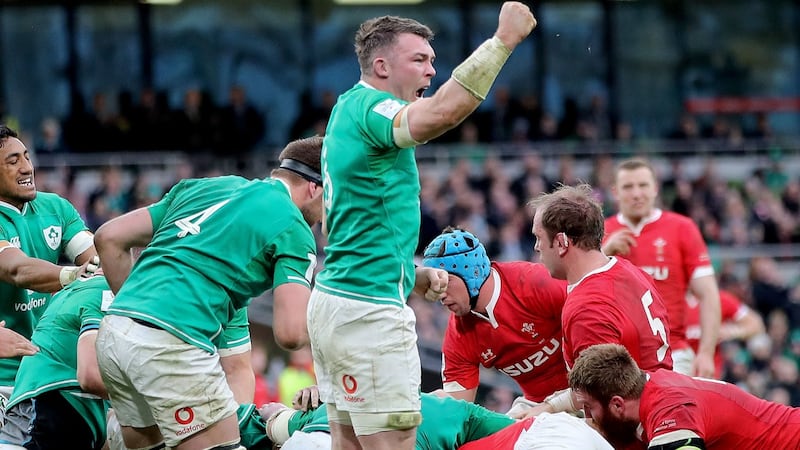"The Box Kick", Leaving Cert English, Paper one. No doubt PhD theses are being written on this subject. Conor Murray kicked last Saturday, but few were box kicks in the classic sense as he chose distance, increasing the metres gained over Scotland by 12 per cent.
I noted on Friday that Ireland were vulnerable and – despite a brilliant win over Wales, scoring four tries – they remain vulnerable. As with any form of transition, the old DNA will at times get mixed with the new. In these moments, even at the elite level of these players, mistakes can occur. To limit this, Ireland managed possession like their lives depended on it. Vast swathes of time went by with the home team owning the ball for 71 per cent of the time in the opening 30 minutes.
This was crucial because, as I noted on Friday, Wales were ferocious in finding the gain-line against Italy and, through direct running, found space just outside the last defender.
Two minutes later Wales secured an off-the-top lineout, with <a class="search" href='javascript:window.parent.actionEventData({$contentId:"7.1213540", $action:"view", $target:"work"})' polopoly:contentid="7.1213540" polopoly:searchtag="tag_person">Justin Tipuric</a> powering into midfield
So keeping Wales to 29 per cent was a huge help. It took Hadleigh Parkes a massive 12 minutes to carry over the gain-line. I also welcomed the return of Taulupe Faletau against Italy, and he is clearly a world class player, but Faletau’s first meaningful touch of the ball in the Aviva was in the 25th minute with over a quarter of the match gone.
Once again Ireland benefited from limiting his role. Two minutes later Wales secured an off-the-top lineout, with Justin Tipuric powering into midfield. Faletau provided the next power carry, but passed before contact, not before interesting four Irish midfield defenders, which afforded space wider out. He carried a few phases later and, then, the peerless Alun Wyn Jones gets his hands free between Cian Healy and Murray to create the Welsh try. Ireland needed to deny Wales possession.
Subtle difference
There’s a subtle difference over the week between Scotland and Wales, but a more obvious one over the year since Wales beat us to win the Grand Slam. Then Ireland (in the rain) ran 227 metres. They made an impressive 41 per cent increase last Saturday and once again, week on week, it is the Irish outside backs making the metres. This is most pleasing, especially when that flow of ball becomes better utilised.
I think of the impact Jones made in the Welsh try and think of how Wales employ Faletau. Then I think of players like James Ryan, Iain Henderson, Caelan Doris, Max Deegan et al running in tandem with Jordan Larmour across the 70-metres wide pitch and look forward to how much more damage a co-ordinated, settled attacking policy will deliver.
Once again Ireland split the pitch, regularly denying the Welsh defensive blitz on both sides of the breakdown. Larmour's try was born out of this approach but, paradoxically, Ireland hadn't exposed a weak side – Wales did that themselves. This approach will continue to provide opportunities, but during this transition Ireland remain vulnerable. Wider rucks such as Dan Biggar's steal on Jacob Stockdale are prone to pilfering. And much of Ireland's wider play is being shepherded neatly towards touch. All will improve – be patient.

The box kick is a failure where the pace of the ball limits the scrumhalf to this one last option
Of course, none of this matters should the pack not at least find parity, and Tadhg Furlong deserves a special mention for his scrummaging and overall performance. That he battled in an attacking scrum is his job, but that he mustered up the energy, focus and dogged determination seconds later to batter over for Ireland's second try gives an insight into the mental and physical fortitude of this class player. Hopefully the so-called "dog" requirements apparently lacking from Irish forwards can manifest in this manner. Furlong chose not to be a dog, but to simply impose himself on the Welsh in his specific way. Bravo!
Defensive engagement
As for imposing on the opposition, I enjoyed the first Irish defensive engagement of the game, when Wales exited from the Irish kick-off. The Welsh exiting pod led by Ken Owens was met by Ryan, Furlong and Ireland's centre Bundee Aki. Yes, a back hunting for the hit. And these players recognised that they were vulnerable individually, and as a team and needed to step up physically.
This physicality is needed to dominate possession, but equally to provide a far cleaner platform for the Irish scrumhalf to keep pace on the ball. To my mind the box kick is a failure where the pace of the ball limits the scrumhalf to this one last option. Hence it was a massive improvement that Murray felt less need to employ this tactic. In the latter stages of the match Ireland became one out once more, with Johnny Sexton carrying into contact along with many of the forwards. This is a nod to the old DNA, the scoreboard and the value of a win for Ireland, the players and especially the management.
Having commented on Saturday morning about a growing happiness within the squad, I was subsequently informed by Twitter moments before kick-off that “I would worry when I start hearing words like ‘the players are happier’”. This tweeter’s simple thesis was that “players won’t be happier when they start to lose”. For this very reason, and for many more I’ll explore over coming weeks, I’m so happy that the players and management are happy – and especially that they are also winning.
liamtoland@yahoo.com













